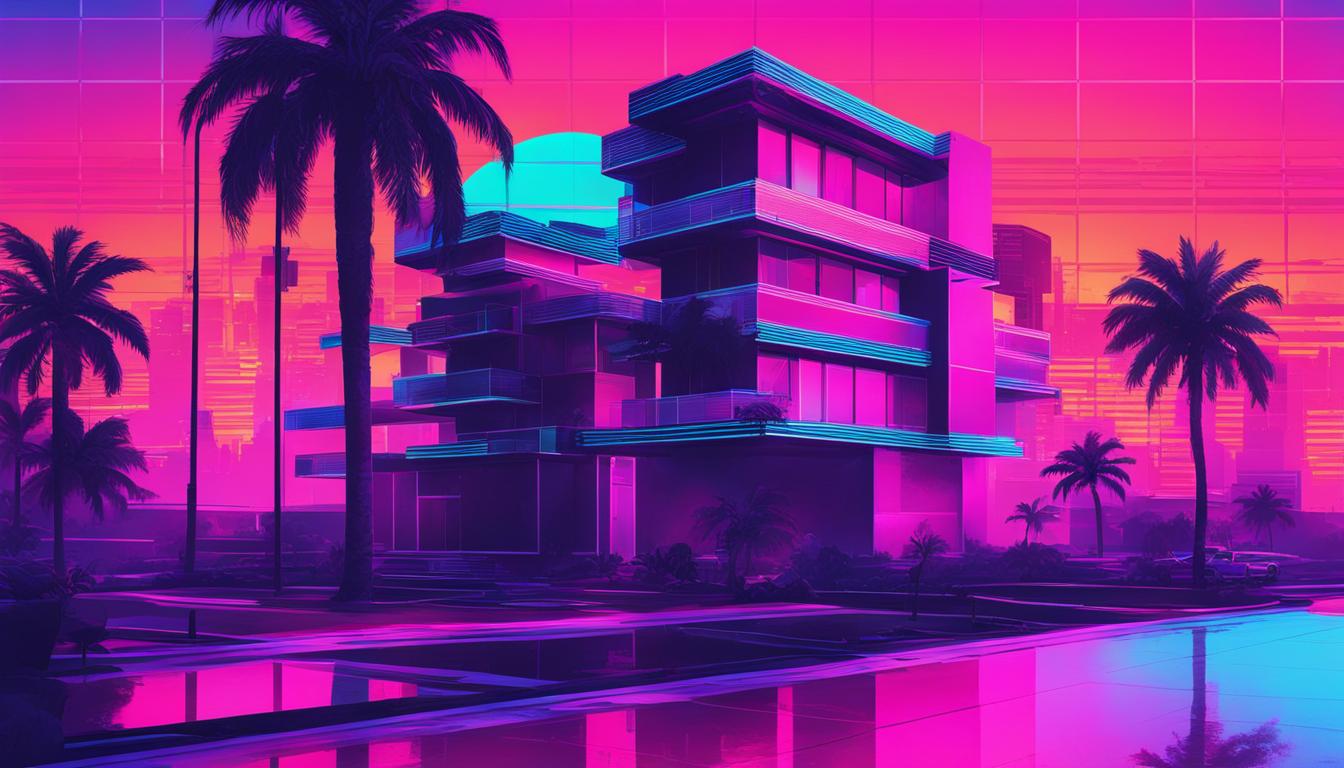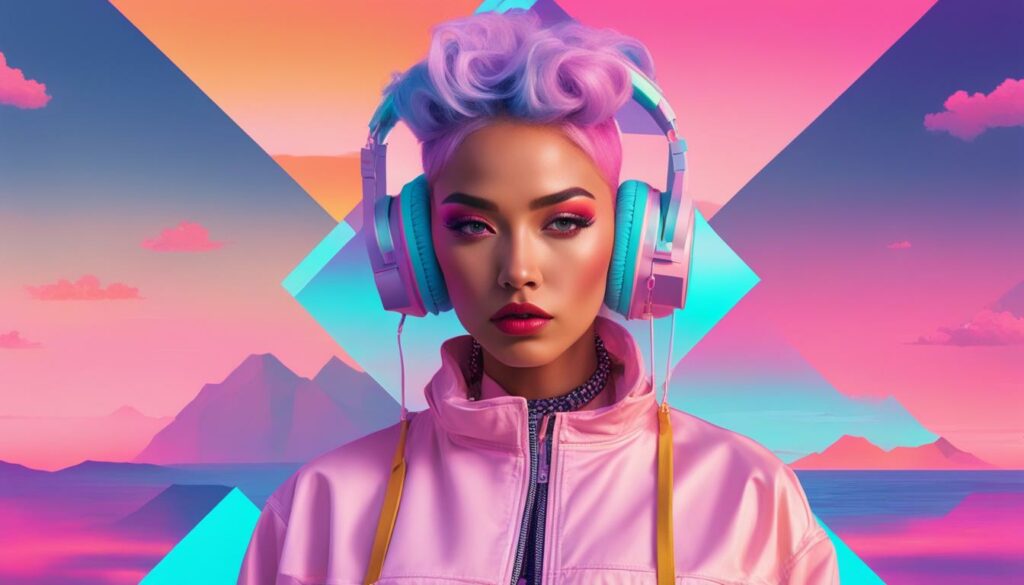No products in the cart.

Welcome to our exploration of the captivating world of vaporwave style. Rooted in retro aesthetics and the aesthetic movement, vaporwave style is a unique blend of 80s nostalgia, nostalgic vibes, and digital art. With its mesmerizing visuals and evocative music, vaporwave has become a beloved phenomenon in pop culture. So, let’s dive in and uncover the essence of this fascinating subculture.
Vaporwave, a distinctive microgenre of electronic music and visual art, has its roots in various musical and cultural movements of the early 2010s. One of the key influences on vaporwave is chillwave, a genre characterized by its dreamy, nostalgic soundscapes. Chillwave emerged in the late 2000s and gained popularity for its lo-fi production, 80s synth-pop influences, and hazy, laid-back vibes. Vaporwave built upon these elements and took them in a new direction, adding its own unique twist.
Hypnagogic pop is another genre that played a significant role in the development of vaporwave. Often described as a form of musical time travel, hypnagogic pop incorporates samples and techniques that evoke a sense of nostalgia and half-remembered memories. Artists like Ariel Pink and Dean Blunt were key figures in this genre, and their experimental approaches paved the way for the emergence of vaporwave.
Other cultural influences on vaporwave include Tumblr seapunk and a revival of retro motifs. The seapunk aesthetic, with its combination of bright colors, aquatic imagery, and nostalgic references, resonated with the vaporwave community. Additionally, vaporwave embraced retro-revivalist motifs, drawing inspiration from the visual styles of the 80s and 90s, including old commercials, VHS tapes, and retro video games.
Vaporwave built upon the foundations of chillwave, hypnagogic pop, Tumblr seapunk, and retro-revivalist motifs to create its own distinct style, characterized by its nostalgic sound and visually engaging aesthetics.
| Influences | Description |
|---|---|
| Chillwave | A genre known for its dreamy soundscapes and nostalgic vibes. |
| Hypnagogic Pop | Music that evokes a sense of nostalgia and half-remembered memories. |
| Tumblr Seapunk | Aesthetic combining bright colors, aquatic imagery, and nostalgic references. |
| Retro-Revivalist Motifs | Inspiration drawn from the visual styles of the 80s and 90s. |
Vaporwave’s origins and influences demonstrate its unique position within the music and art landscape. By building upon the foundations of previous genres and cultural movements, vaporwave has carved out its own niche, captivating audiences with its nostalgic sound and visually compelling aesthetics. In the next section, we will explore the defining characteristics of vaporwave that set it apart from other genres.
Vaporwave is a unique and hyper-specific subgenre that seamlessly combines elements of electronic music and visual art. Musically, it takes dance music from the 1980s and early 1990s and reconfigures it through the use of chopped and screwed techniques, repetition, and heavy reverb. The result is a dreamy and nostalgic soundscape that captures the essence of the vaporwave movement.
One of the defining characteristics of vaporwave is its reliance on samples and basic production techniques. Unlike other genres that require complex compositions and intricate sound design, vaporwave is composed almost entirely from slowed-down samples. This minimalist approach allows for a focus on atmospheric textures and creates a sense of languidness and introspection in the music.
Visually, vaporwave is just as distinctive as its sound. The genre incorporates early Internet imagery, glitch art, anime, stylized Greek sculptures, and 3D-rendered objects to create a visual aesthetic that is both nostalgic and futuristic. This blend of retro and modern influences reflects the genre’s whimsical and self-aware take on consumerism and popular culture. The use of these visual elements adds another layer of depth and immersion to the vaporwave experience.
Overall, vaporwave stands out as a hyper-specific microgenre that combines electronic music and visual art in a truly unique way. Its characteristic use of slowed-down samples and minimalist production techniques, coupled with its visually engaging aesthetics, have contributed to its enduring popularity among fans of electronic music and art enthusiasts alike.
“Vaporwave is like revisiting a neon-lit dreamscape of the past, where the sounds of elevator music and catchy electronic beats coalesce to create a soothing and nostalgic ambiance.” – Anonymous fan.
| Characteristic | Description |
|---|---|
| Sample-based composition | Vaporwave relies heavily on slowed-down samples from 1980s and 1990s music, creating a nostalgic and dreamlike atmosphere. |
| Minimalist production | The genre requires only rudimentary production techniques, allowing for a focus on atmospheric textures and introspection. |
| Visual aesthetics | Vaporwave incorporates early Internet imagery, glitch art, anime, and stylized Greek sculptures to create a unique visual aesthetic that reflects its nostalgic and futuristic themes. |
Vaporwave has made a significant impact on pop culture, permeating various aspects of modern society. The genre’s distinct visual aesthetic has influenced fashion trends, particularly in streetwear, where retro graphics and logos, pastel colors, and a fusion of vintage and futuristic styles have become popular.
With its origins tied to early Internet imagery and glitch art, vaporwave embodies internet aesthetics and cyberpunk tropes. The genre’s nostalgic engagement with previous decades’ popular entertainment, technology, and advertising has resonated with a generation seeking a connection to the past while embracing the digital age.
“Vaporwave represents a unique fusion of nostalgia and futuristic elements that captivates and inspires its audience. It encapsulates a sense of longing for a bygone era while embracing the potential of the future.”
The genre’s influence extends beyond fashion, with its music and visuals gaining widespread recognition on social media platforms. Vaporwave-inspired content is widely shared and memed, solidifying its status as an internet phenomenon. The genre has also given rise to a range of subgenres and offshoots, further expanding its influence within the broader cultural landscape.
The impact of vaporwave fashion can be seen in the rise of streetwear brands that incorporate elements of the genre’s visual aesthetics. Iconic vaporwave symbols such as stylized Greek sculptures, 3D-rendered objects, and Japanese characters have become hallmarks of the style. Additionally, the fusion of retro and futuristic elements in vaporwave fashion has attracted a dedicated following, resulting in art exhibitions and fashion shows dedicated to the genre.
Overall, vaporwave’s impact on pop culture is undeniable. From fashion trends to internet aesthetics, this hyper-specific subgenre continues to shape and inspire various artistic expressions. Its ability to evoke nostalgia and create a unique fusion of the past and future has solidified vaporwave’s place within the cultural zeitgeist.

Vaporwave’s distinct visual aesthetics and nostalgic motifs have had a significant impact on fashion and art. The genre’s blend of vintage and futuristic styles, coupled with its embrace of digital art and internet culture, has attracted a dedicated following. Vaporwave fashion often incorporates pastel colors, retro graphics and logos, Japanese characters, and a blend of vintage and futuristic styles.
Artists and designers have been inspired by vaporwave’s unique visual language, resulting in a range of vaporwave-inspired creations. From clothing lines to digital artworks, the style has gained popularity among internet subcultures and has been featured in art exhibitions and fashion shows.
Visual art in the vaporwave movement encompasses various mediums, including digital art, glitch art, and 3D-rendered objects. Artists use these mediums to create visually engaging pieces that capture the essence of vaporwave. The genre’s influence on internet culture is evident in the way its visual aesthetics have permeated online platforms, with vaporwave-inspired imagery widely shared and appreciated.
Vaporwave fashion and art serve as a reflection of the genre’s larger cultural impact. By recontextualizing elements from the past and combining them with futuristic elements, vaporwave captures a sense of nostalgia while simultaneously embracing the possibilities of the digital age. The genre’s influence on fashion and visual art continues to shape contemporary culture and inspire new creative expressions.
In conclusion, vaporwave has left a lasting impact on pop culture, captivating audiences with its nostalgic appeal and influencing various aspects of contemporary society. The genre’s slowed-down samples, distinct visual aesthetics, and references to internet culture have garnered a dedicated following and sparked the exploration and evolution of subgenres.
Vaporwave’s influence extends beyond music, as it has shaped fashion trends, art movements, and even internet memes. The genre’s distinctive characteristics, such as its retro graphics, pastel colors, and fusion of vintage and futuristic styles, have made a significant impact on fashion, with vaporwave-inspired clothing becoming popular in streetwear.
Moreover, the genre’s visual aesthetics have transcended into the art world, with artists incorporating digital art, glitch art, and internet culture references in their work. Vaporwave’s ability to evoke nostalgia and transport individuals to a bygone era has made it a captivating and influential force in contemporary art.
While some may label vaporwave as a “dead” genre, its legacy lives on through its influence on subgenres and its continued impact on popular culture. Whether through its appeal to nostalgia, its ability to inspire new artistic expressions, or its catchy melodies, vaporwave has undeniably left a lasting imprint on the cultural landscape.
Vaporwave is a microgenre of electronic music and a subgenre of Hauntology that emerged in the early 2010s. It is characterized by its slowed-down, chopped and screwed samples of smooth jazz, R&B, and lounge music from the 1980s and 1990s. The surrounding subculture is associated with an ambiguous or satirical take on consumer capitalism and pop culture and is characterized by a nostalgic engagement with the popular entertainment, technology, and advertising of previous decades.
Some of the pioneer artists in the vaporwave genre include James Ferraro, Daniel Lopatin, and Ramona Xavier.
Vaporwave has influenced fashion and art with its distinct visual aesthetics and nostalgic motifs. Vaporwave fashion often incorporates pastel colors, retro graphics and logos, Japanese characters, and a blend of vintage and futuristic styles. It embraces digital art, glitch art, and internet culture, with artists using various mediums to create vaporwave-inspired visuals.
Vaporwave has had a significant impact on pop culture, particularly in terms of its nostalgic appeal and influence on fashion, art, and music. The genre’s distinctive characteristics, including its slowed-down samples, visual aesthetics, and internet culture references, have attracted a dedicated following. Vaporwave has inspired a range of subgenres and offshoots, each with its own unique characteristics and influences.
